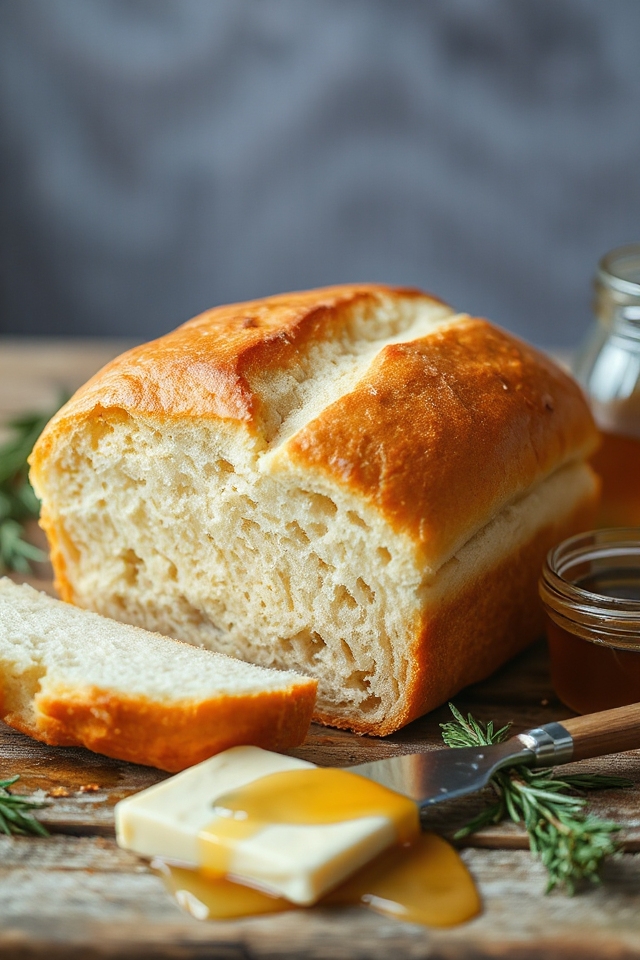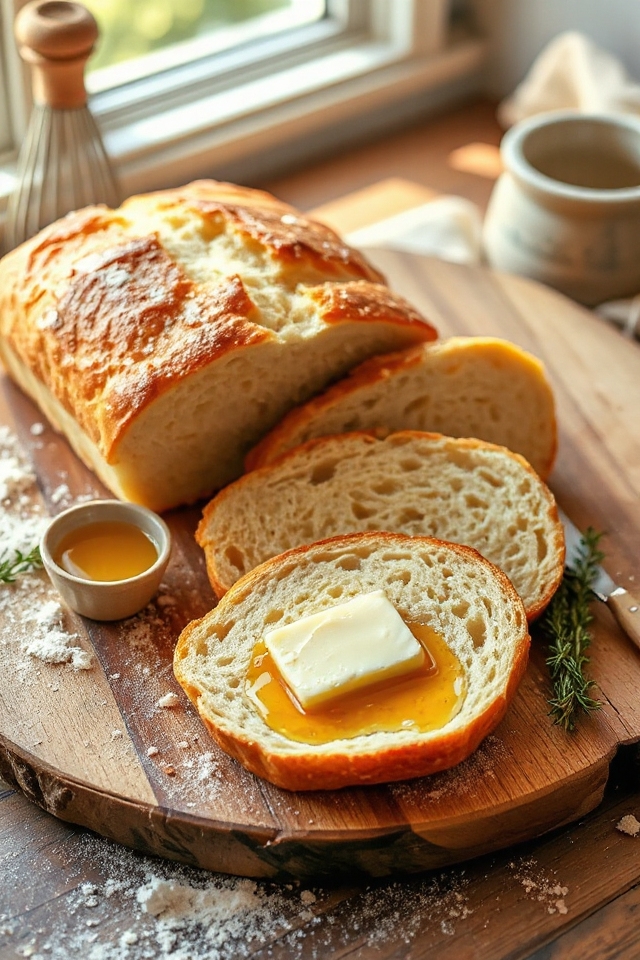Why You’ll Love this Buttermilk White Bread Recipe
You’ll absolutely love this Buttermilk White Bread recipe for its incredible flavor and texture. The moment you slice into the warm, golden crust, you’ll be greeted by a soft, fluffy interior that melts in your mouth.
I can’t get enough of the rich, tangy taste that buttermilk brings, elevating the bread beyond ordinary. It’s perfect for sandwiches, toast, or just slathered with butter.
The aroma that fills your kitchen while it bakes is simply irresistible. Plus, making it from scratch gives you a sense of accomplishment that store-bought bread just can’t match.
Trust me, you won’t want to stop at one loaf!
Ingredients of Buttermilk White Bread
When it comes to baking, the right ingredients can make all the difference, and this Buttermilk White Bread recipe is no exception. Gather these simple yet essential ingredients, and you’ll be on your way to creating a warm, comforting loaf that will have your kitchen smelling divine.
Plus, there’s just something special about using buttermilk—it adds a tangy richness that sets this bread apart from your average loaf. So, let’s explore what you’ll need to whip up this delicious bread.
Ingredients for Buttermilk White Bread:
- 3/4 cup warm water
- 1 tablespoon active dry yeast
- 1 teaspoon sugar
- 1 1/2 cups buttermilk (room temperature)
- 2 tablespoons melted butter
- 3 tablespoons honey
- 1 tablespoon salt
- 6 1/2 to 7 cups flour
- 1 egg yolk
- 1 tablespoon cold water
Now, before you rush off to grab these ingredients, let’s chat a bit about them. You might be wondering if the type of flour really matters—spoiler alert: it does.
Using all-purpose flour is great for this bread, but if you want to experiment, bread flour can give you a chewier texture due to its higher protein content.
And don’t skip the buttermilk; it’s the secret weapon here, adding moisture and flavor that you just can’t replicate with regular milk. If you don’t have buttermilk on hand, a quick substitute can be made by mixing milk with a splash of vinegar or lemon juice.
Just let it sit for a few minutes, and voila! You’re ready to bake. So gather those ingredients and let’s get crafting that bread!
How to Make Buttermilk White Bread

Alright, let’s roll up our sleeves and get ready to make some Buttermilk White Bread. First things first, you’ll want to start with 3/4 cup of warm water. This is where the magic begins. Sprinkle 1 tablespoon of active dry yeast and 1 teaspoon of sugar over the water. Now, don’t just stand there—give it a little stir and let it sit for about 10 minutes. You should see it getting all frothy and bubbly, which is basically yeast doing its happy dance. If it doesn’t bubble up, well, we might’ve to talk about your yeast’s social life.
Next, grab a large mixing bowl and combine that lovely yeast mixture with 1 1/2 cups of room-temperature buttermilk, 2 tablespoons of melted butter, 3 tablespoons of honey, and 1 tablespoon of salt. Now, here’s the fun part—add about half of the 6 1/2 to 7 cups of flour to the mix. Grab a wooden spoon and start mixing until you’ve got a soft dough forming. Don’t worry if it feels a little sticky; that’s just the dough being a little needy.
Turn it out onto a floured surface and begin kneading, adding 1/2 cup of flour at a time until the dough is smooth and soft—this usually takes about 10 minutes. It’s like giving your dough a nice massage, and trust me, it will thank you later.
Now, let’s give this dough a chance to rise. Spray a bowl with non-stick spray and place your dough inside, turning it over so it’s coated. Cover it up and let it chill at room temperature for about an hour until it doubles in size. Once it’s puffed up, gently punch it down (yes, you can take out some of that daily stress) and turn it onto the counter. Cut it into two equal pieces and shape each piece into a loaf.
Place those beauties in greased bread pans, cover again, and let them rest for another hour. While you’re waiting, you might want to preheat your oven to 375 degrees—this way, you can avoid the dreaded last-minute oven scramble.
After that hour of waiting (which, let’s be honest, feels like an eternity), brush the tops of your loaves with a mixture of 1 egg yolk and 1 tablespoon of cold water. This will help them achieve that gorgeous golden-brown color we all love.
Now, pop them in the oven for about 35 to 45 minutes. You’ll know they’re done when they’re beautifully browned, pull away from the sides of the pan, and sound hollow when tapped. Let them cool on a rack, and then, if you can resist the temptation, wait until they’re completely cool before slicing.
And there you have it—your very own Buttermilk White Bread, ready to be slathered with butter or your favorite spread. Enjoy the deliciousness!
Buttermilk White Bread Substitutions & Variations
After you’ve mastered the basics of making Buttermilk White Bread, exploring substitutions and variations can take your baking experience to the next level.
For a richer flavor, try using whole milk instead of buttermilk, or substitute half the flour with whole wheat flour for a nuttier taste.
If you want a hint of sweetness, add a tablespoon of maple syrup along with the honey.
You can also fold in herbs or spices, like rosemary or garlic powder, for added flair.
Feel free to experiment with different add-ins, like nuts or dried fruits, to personalize your bread!
What to Serve with Buttermilk White Bread
Buttermilk White Bread pairs wonderfully with a variety of dishes, enhancing any meal with its soft texture and rich flavor.
I love serving it alongside hearty soups, like tomato basil or a creamy potato leek. It also complements grilled cheeses perfectly, adding a delightful twist.
For brunch, you can’t go wrong with butter and jam, or even a slice topped with avocado and poached eggs.
When it comes to dinner, try it with roasted meats or a fresh salad.
Trust me, this bread elevates every dish, making your meals feel special and inviting. Enjoy experimenting with your favorites!
Additional Tips & Notes
While making Buttermilk White Bread can seem intimidating, there are several tips that can help guarantee your success.
First, make sure your yeast is fresh; old yeast won’t rise properly. I recommend using room temperature buttermilk for better dough consistency.
When kneading, don’t rush—aim for that soft, smooth texture. If your dough feels too sticky, add flour gradually until it’s manageable.
Always let the dough rise in a warm, draft-free spot.
Finally, brushing the loaves with egg yolk gives a beautiful golden crust. Trust me, these small tweaks can elevate your bread-making experience! Enjoy the process!
